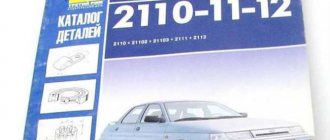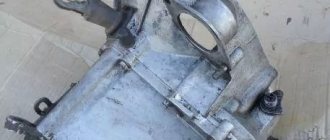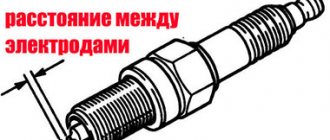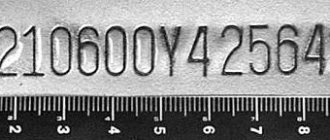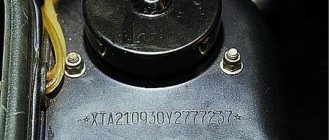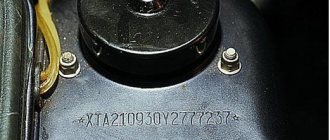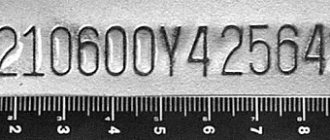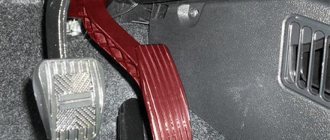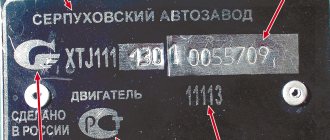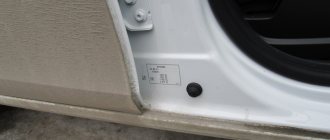VAZ engine number
The marking on the engine is applied to a special area of the cylinder block.
The labeling process is mechanized. On engines produced before December 1974 (VAZ-2101, VAZ-2102, VAZ-2103), the marking area was located on the front upper end of the cylinder block.
Since the second half of 1975, the marking area on engines has been located on the tide of the block, to the left in the direction of travel, above the oil filter. On engines manufactured from December 1974 to July 1975, markings are found on both sites. Since July 1975, at the previous location of the engine number, only the engine technological number, consisting of three digital characters, has been applied.
Photo. General view of the number applied to the engines of VAZ-2101-VAZ-2107 cars.
Markings are applied to engines of all models, except the VAZ-2108, using an automatic German numbering machine, as well as a VAZ KVTs numbering machine. On the engines of VAZ-2108 cars, markings are applied with a numerator.
Rice. Engine numbers, made on a metal plate with a numerator: a) - ; b) — VAZ KVTs; V) - . The sizes of this font and stamp imprints are shown in the figures.
Rice. Custom non-guest font options
Rice. Sign imprints made on a metal plate
On engines of VAZ-2108 and VAZ-2109 cars and their modifications, the number is located on the upper part of the rear wall of the block on the flywheel side, to the left in the direction of travel (close to the distributor breaker).
The surface of the site is subjected to mechanical processing on a milling machine before marking is applied. On the engine blocks of VAZ-2101, VAZ-2102, VAZ-2103, VAZ-21011, VAZ-2104, VAZ-2105, VAZ-2106, VAZ-2107, VAZ-2121 and their modifications, not only the platform for markings, but also surfaces for the oil filter and fuel pump.
The location of the number on the site relative to its conventional center or boundaries is not regulated.
The serial number on engines, starting with the VAZ-2108, must be between two asterisks (dividing marks). The distance between the outer digits and asterisks on each side, as well as the distance between individual markings, should be no more than half the width of the digit.
From 1984 to 1985, on VAZ-2108 car engines, the placement of signs in the number was carried out in two lines, then from 1986 - in one line.
Photo. General view of the number applied to the engines of VAZ-2108 cars and their modifications
Rice. Parameters and location of characters in the number designation: a - in two lines; b - in one line
The year of engine manufacture is indicated by letters of the Latin alphabet. In the number designation (in particular, on VAZ-2108 engines and its modifications), the letter indicating the year of manufacture is located immediately after the model index, and the number looks like this: “2108f* 0000001*. The letter F indicates that the engine was manufactured in 1985.
List of letters of the Latin alphabet used to indicate the year of manufacture of the engine.
Year
Designation
Year
Designation
In 1985-1986 all engines of VAZ-2108 cars and its modifications contained a letter in the number indicating the year of manufacture. Since 1987, it began to be applied in the number not to all engines, but mainly to those that entered the domestic market, since car importing countries asked not to include a letter of the Latin alphabet indicating the year of manufacture in the designation of the engine number. Abroad, the presence of a letter in the number immediately after the model was perceived as a modification of the main model. In this regard, since 1987, the plant practically ceased to indicate the year of manufacture on VAZ-2108 engines, since there was no clear distinction between products that were to be sold on the domestic market and those that would be sold abroad.
VAZ 2123 engine - features
The VAZ 2123 engine for the Chevrolet Niva has received many changes that have a better effect on its functional characteristics.
Unlike its predecessor models, it has a different generator location. He is now on top.
1 — oil pan; 2 — main bearing cover; 3 — connecting rod cover; 4 - crankshaft; 5 — connecting rod; 6 - piston; 7 — piston rings; 8 - valve; 9 — valve guide; 10 — valve springs; 11 - plate; 12 - camshaft; 13 — cylinder head cover; 14 — valve lever; 15 - hydraulic support; 16 — cylinder head; 17 — spark plug; 18 — cylinder head gasket; 19 — generator bracket; 20 — cylinder block; 21 — oil pump gear retainer; 22 — oil pump gear; 23 — oil filter bracket; 24 — oil pan gasket; 25 - oil pump
Checking the vehicle's equipment
The new cylinder block is based on the old one, but despite this it has its own marking. The main change affected the way the oil filter is mounted. In older models it was screwed directly into the block, but now a special bracket is used for connection. It performs another function - it is a support for mounting the power steering pump.
The flywheel received an increased diameter, as a result of which its working surface became 215 mm.
A new pump has been installed, inside of which a roller bearing is located. Unlike the old ball bearing, the new type of bearing has an increased service life.
The water pump, power steering pump and generator are driven by a pulley mounted on the crankshaft. The system includes tension and support rollers. The pulleys themselves are made according to a special design, adjusted to the belt profile.
1 — tension roller of the air conditioning compressor drive belt; 2 — air conditioning compressor drive belt; 3 — air conditioning compressor clutch; 4 — thermostat; 5 — throttle assembly; 6 — outlet pipe of the cooling jacket; 7 — coolant pump pulley; 8 - phase sensor; 9 — tension roller for the auxiliary drive belt; 10 — cylinder head; 11 - generator; 12 — power steering pump pulley; 13 — support roller for the auxiliary drive belt; 14 — cylinder block; 15 — auxiliary drive belt; 16 — crankshaft position sensor; 17 — auxiliary drive pulley; 18 — air conditioning compressor drive pulley; 19 — oil pan; power unit support; an exhaust manifold; receiver; cylinder head cover;
Changes also affected the design of the engine compartment. The front axle gearbox is no longer attached to the engine. This required changes to the internal engine compartment.
A new air intake system is installed in the VAZ 2123 engine. The volume of its body has increased significantly due to the increased size of the air filter, which can now be changed less frequently.
The engine is also controlled by new controllers. Depending on the modifications, BOSCH or JANUARY controllers can be installed.
Where is the engine number on a Chevrolet Niva
Engine number: where is it located, as it stands for
Initially, the Chevrolet Niva (VAZ 2131) was designed as a second generation Niva with the factory marking VAZ 2123. Due to a lack of funding, in 2001 the model came under the jurisdiction of Chevrolet along with the name Niva. The predecessor of the new Niva had a VAZ 2121 (1.5 liters) power plant, which underwent changes and was introduced to users in the 90s as the VAZ 21213 (1.6 liters). Later, having removed the carburetor and switched to injection, the modification began to be labeled as VAZ 21214 and complied with Euro-4 standards. The 1.7 liter modification is marked VAZ 212140-28
Finding the markings on the motor is not difficult; the model and number are marked on the frame platform, located horizontally on the left side of the unit
When searching, pay attention to the plane where the block and head open, in the area of the spark plugs of the third and fourth cylinders
Engine number on Niva (VAZ 21214):
Information about the car is displayed on an identification plate, which is attached with rivets in the space under the hood. You can find the plate by looking at the right side of the front body panel.
Identifier plate and VIN code:
The Niva body identification number (VIN code) is stamped to the side of the plate. This identifier is in duplicate, the second is stamped on the floor in the luggage compartment; to access, remove the upholstery.
VIN code in luggage compartment:
Where are the VIN numbers on the Chevrolet Lacetti?
Where to look for the VIN code or body number of a car from RDM-Import
Where to look for the VIN code or body number of a car from RDM-Import
Chevrolet Aveo engine number
Chevrolet Aveo engine number
Chevrolet Lacetti body inspection - Avtopodbor116.rf
Chevrolet Lacetti body inspection - Avtopodbor116.rf
Look before buying Chevrolet Lacetti!!!
Look before buying Chevrolet Lacetti!!!
Where is the VIN (code) body number of the 2008 Chevrolet Aveo
Where is the VIN (code) body number of the 2008 Chevrolet Aveo
Damaged car VIN code
Be careful when purchasing! https://www.youtube.com/embed/58a4gAyIBZQ
Damaged car VIN code. Be careful when purchasing!
Car body number: Where it is usually found and how to look for it.
Car body number: Where it is usually found and how to look for it.
Inspection of the Chevrolet lacetti - I haven’t seen such trash for a long time!
Are you buying a used car? Check the engine number!
Are you buying a used car? Check the engine number!
Vin code of Lacetti car
Also see:
- Niva Chevrolet remove snail
- Body kits for Chevrolet Cruze hatchback
- Thermostat temperature sensor on a Chevrolet Cruze
- Installing fog lights on a Chevrolet Aveo 2014
- White light bulbs Chevrolet Cruze
- Chevrolet Lacetti ignition system diagram
- Chevrolet US models
- Find out the Chevrolet Cruze error code
- Bad reviews of the Chevrolet Trailblazer
- Halogens on a Chevrolet Cruze
- What antifreeze to fill in Chevrolet Aveo 2014
- Niva Chevrolet electrical relay diagram
- Driver for usb elm327 Chevrolet
- How to change a fog light on a Chevrolet Captiva
- Cricket in the dashboard of a Chevrolet Lacetti
Home » Collections » Where are the vin numbers on the Chevrolet Lacetti www.chevrolet-perm.ru
Niva 21213, Solex carburetor 21073, high consumption. Disassembling the Niva VAZ 21213 engine for repair ICE theory: Engine 21213 1.9 l for Niva
You will also like:
Where is the engine number on a Lada car?
(No ratings yet) Chevrolet body color codes (table)
| Color | Color code | Color name |
| 04U, 402N, 658R, 685R, GQW, WA402N, WA658R, WA685R | Urban gray metallic | |
| 06U, 403N, 660R, GQV, WA403N, WA660R | Flame red metallic | |
| 10, 9567, G8G, WA9567 | Arctic white | |
| 11, 703S, GBU, WA703S | Ice White | |
| 12, 519Q, GIP, WA519Q | Dark Brahma Jewel metallic | |
| 13, 573Q, GIS, WA573Q | Merlot Jewel metallic | |
| 13U, 265L, GBQ, WA265L | White Pearl | |
| 15, 929L, WA929L | Cashmere metallic | |
| 152D, 16, 17, WA152D | White | |
| 156L, 33U, 895T, GQM, WA156L, WA895T | Sports blue metallic | |
| 16, 213M, GIW, WA213M | Greystone metallic | |
| 17, 636R, GAN, WA636R | Switchblade Silver Metallic | |
| 18, 726S, GGZ, WA726S | Sheer silver metallic | |
| 19, 19U, 990A, WA990A | Licorice Black/Jet Black | |
| 19B, 216N, 316N, 51, GAO, WA216N, WA316N | Gold Fog metallic | |
| 19U, 23U | Jazz Blue | |
| 21, 218M, WA218M | Laser blue metallic | |
| 229L, 52U, GOC, WA229L | Highway Yellow | |
| 23, 349D, WA349D | Medium Blue | |
| 23, 563Q, GBX, WA563Q | Atlantic blue metallic | |
| 238L, 71U, 73L, 73U, GGE, WA238L | Super red | |
| 246L, 92U, GCY, WA246L | Poly silver metallic | |
| 25, 722J, WA722J | Dark Min blue metallic | |
| 253A, 86, 9W3, WA253A | Wheatland Yellow | |
| 28, 502Q, GCR, WA502Q | Inferno Orange Metallic | |
| 300N, 45, G8A, WA300N | Speed Yellow Tintcoat | |
| 301N, 80, GAQ, WA301N | Red Jewel Tintcoat metallic | |
| 33, 718S, GGU, WA718S | Evolution blue metallic | |
| 34, 9414, GCO, WA9414 | Yellow | |
| 37, 403P, GAP, WA403P | Imperial Blue Metallic | |
| 39, 9792, WA9792 | Indigo blue metallic | |
| 3F | Metallic gray alloy | |
| 3G, 507J, WA507J | Shanghai red metallic | |
| 406P, 48, WA406P | All Terrain Blue | |
| 41, 8555, GBA, WA8555 | Black | |
| 412P, 66, GCE, WA412P | Sonoma Jewel metallic | |
| 414P, 81, WA414P | Cocoa metallic | |
| 428L, 46, 836, 928L, G56, WA428L, WA928L | Stealth gray metallic | |
| 434N, 47U, GKH, WA434N | Poseidon blue metallic | |
| 435N, 53U, GKD, WA435N | Kandinsky red metallic | |
| 436N, 55U, GKE, WA436N | Linen beige metallic | |
| 45U | Apple Green Metallic | |
| 46, 7156, 9V5, WA7156 | Dark Forest Green | |
| 47, 9539, WA9539 | Medium Green Metallic | |
| 50, 50U, 8624, 926A, GAZ, WA8624, WA926A | Blue White/Olympic White | |
| 501Q, 58, GAR, WA501Q | Carbon Flash Drive Metal | |
| 505Q, 89, GBE, WA505Q | Crystal Claret metallic / Crystal Claret Tintcoat | |
| 512Q, 85, WA512Q | Blue Thread Tintcoat | |
| 517Q, 79, WA517Q | Merlot Jewel metallic | |
| 53 | Pearl silver- | |
| 560Q, 94, GBR, WA560Q | Platinum Ice Metallic / Platinum Ice Tricoat | |
| 565Q, 58, GAR, WA565Q | Carbon Flash Drive Metal | |
| 56U | Electric yellow metallic | |
| 57, 618U, 637R, GBV, WA618U, WA637R | Cyber gray metallic | |
| 59 | Desert Gold Metallic | |
| 61, 638R, GBD, WA638R | Aqua Blue Metallic | |
| 61, 8265, 9V9, WA8265 | Doeskin Tan | |
| 62, 707S, GGW, WA707S | Dark Labyrinth metallic | |
| 63, 817K, WA817K | Sports red metallic | |
| 633R, 92, GAV, WA633R | Urbana Moss metallic | |
| 642R, GIM, WA642R | Tiara Tan metallic | |
| 681R, GCS, WA681R | Velvet red metallic | |
| 682R, GCT, WA682R | Moroccan Blue Metallic | |
| 683R, GCW, WA683R | Misty Lake metallic | |
| 686H, 96, 96U, GCD, WA686H | Bright white | |
| 70, 9075, GKZ, WA9075 | Torch Red | |
| 706S, GHA, WA706S | Magna steel metallic | |
| 708S, GHS, WA708S | Synergy green metallic | |
| 713S, GHT, WA713S | Swerve green metallic | |
| 715S, GGT, WA715S | Seraphim Orange metallic | |
| 72, 7475, WA7475 | Standard Red | |
| 720S, GHF, WA720S | Kinetic blue metallic | |
| 721S, GHR, WA721S | Pulse Yellow metallic | |
| 726R, GJT, WA726R | Metallic cocktail green | |
| 727R, GJU, WA727R | Coconut champagne metallic | |
| 728R, 98U, GEL, WA728R | Dynamic Orange Metallic | |
| 729R, GJS, WA729R | Ice Teal metallic | |
| 74, 9260, GCN, WA9260 | Victory of the Red | |
| 800J, 98, GBN, WA800J | White Diamond Pearl | |
| 876S, GMN, WA876S | Desert Bloom metallic | |
| 88, 9417, 9W4, WA9417 | Tangier Orange | |
| G.C.U. | Atlantis Blue Metallic | |
| GCV | Tin gray metallic | |
| GCZ | Metallic gold light | |
| G.J.D. | Thunder gray metallic |
Also interesting: New Chevrolet Niva 2021 - video
The need to check the engine number
Where is the engine number on the grant?
Until recently, the engine number of the Niva Chevrolet and other car brands was a mandatory attribute entered into the car’s passport. According to the new rules, this information is not required. However, when a car or engine is identified, there is simply no other option. Therefore, traffic police officers maintain a database of license plates with which they compare a particular vehicle.
For this reason, every responsible user knows where to find the engine markings and where the body number is located on the Niva. In addition, the driver’s responsibilities include caring for the location of this information.
Tuning
Where is the engine number on the VAZ 2110
There are several ways to increase the power of a Niva engine. We will tell you in more detail about these methods of tuning the VAZ 21213.
- Deep engineering tuning of the Niva engine with crankshaft replacement and cylinder boring. This kind of work allows you to increase the working volume of this engine to 1.95-2.1 liters. Accordingly, when adjusting the injector, the VAZ 21213 engine receives power of about 100 horsepower.
- Chip tuning of the Niva engine allows you to get about 10 additional horsepower at minimal cost. In this case, the work does not pose any difficulty. You just need to select the appropriate chip tuning and reprogram the engine control unit. The advantage of this option is the complete preservation of engine life.
- Installation of turbines and compressors on VAZ 21213 engines. In this case, we can recommend that you use compact turbines with a pressure of no more than 0.5 bar. At the same time, the injector is reconfigured and the oil and fuel pumps are replaced. It is necessary to understand that such work should only be performed by a specialist who knows the features of the VAZ 21213 engine.
Also interesting: VAZ (Tolyatti)
Note that installing a turbine and boring the Niva engine invariably negatively affects its service life. Therefore, the car owner needs to weigh the pros and cons, and only after that perform tuning of the Niva engine.
Air flow
The ambient temperature sensor is replaced according to the sequence presented below.
- Disconnect the negative terminal of the battery by de-energizing the network.
- Remove the front bumper for ease of work.
- Squeeze the three blades of the lock.
By carefully pulling the meter, remove the sensor from the mounting hole of the bracket.
- Press the pad lock.
- Disconnect the meter terminal block.
The air flow of the Niva Chevrolet is controlled using a hot-wire sensor, which is located between the hose of the intake pipe and the air filter. The magnitude of the direct current depends on the direction and amount of moving air that passes through it. In the event of a system malfunction, a code is stored in memory and the alarm is activated.
To replace, you need to prepare a 10mm wrench and a screwdriver and do the following:
- Disconnect the connector from the sensor
- Loosen the air pipe clamp
- We unscrew the bolts that secure the sensor and the o-ring
- Installing a new one
Fuse blocks VAZ Niva 21214
Any car is equipped with fuse blocks (FBs), which are responsible for the safety of electrical circuits. Their location differs not only depending on the make of the car. Even models from the same manufacturer that are close in year of production can be placed in different patterns. However, in some cases the location may coincide completely.
Where are the blocks and relays located in Niva 21214 and 21213
The main power supply in these models is located under the lower edge of the instrument panel protection. Additional fuses in Niva 21214 for the injector are located to the left. This block is responsible for controlling fuel injection. There are also relays for monitoring the operation of the wipers and a set responsible for the motion control system.
Another fuse box is installed in the body to the left of the main one. They are responsible for the cooling system and how the engine works. There is also a diagnostic connector. The relay that controls the starter is located either next to the main power supply, or under the hood next to the brake fluid reservoir.
Designations of fuses and their purpose
Each of the fuses (FC) is responsible for a separate element of the vehicle's electrical circuit. In the main block, the numbering goes from left to right. There are 16 elements in total: 10 in the top row and 6 in the bottom.
Description of the upper section:
- Rear wiper motor, fluid supply to the front window, heater fan motor.
- Turn signals, reverse indicator, switches under the steering wheel, instrument panel and indicator lights.
- High beam (left headlight), indicator on the dashboard for turning on the high beam.
- High beam (right headlight).
- Low beam (left headlight).
- Low beam (right headlight).
- Dimensions (left side), license plate lighting, indicators on the instrument panel for turning on the dimensions.
- Dimensions (right side), instrument panel lighting.
- Hazard signal relay and power button, heated rear window.
- Brake lights, interior lighting, horn.
All fuses except the first have a rated current of 8A (PR1 - 16A). The bottom row is responsible for the following:
Storing the 8A insert Similar to the previous one. Rear fog lights. Cigarette lighter. Storage of 16A insert. Same for 8A.
The next power supply is responsible for the operation of the engine. The fuse diagram for Niva 21213 assumes 5 positions, and VAZ 21214 with an installed ABS system - 7 (positions 5-7 are responsible for it). The circuit without ABS looks like this:
Start the electric fan motor on the right (30A). A similar position for the left side. Injection system control, injection nozzles, ignition coil, fan relay (15A). System for reducing the toxic component of gases, sensor of air supplied to the internal combustion engine (15A). Connector for diagnosing the operation of the injection system.
Relay blocks
The location of these blocks should be clarified according to the vehicle documentation. Also, some car enthusiasts sometimes tolerate them. Therefore, when buying a used car, it is better to check about possible changes. Engine control system unit from left to right:
Ignition. Engine starting system. Right radiator fan. Similar left fan. Fuel pump operation. PR power supply for the fuel pump (15A).
The last key relay block, located above the gas pedal, is responsible for the lighting and heated rear window.
Diagram and location of the fuse box Niva VAZ-21213 and 21214
In this material we will introduce you to the Niva fuse box 21213 and 21214, the purpose of the fuses, and the nuances of the additional VAZ-21214 fuse box, which is responsible for the injection system and is located in a separate block on the left side under the instrument panel. Externally the block looks like this:
The fuse numbers in it are as follows:
And here’s what a separate injection system unit looks like; by the way, it contains the electric fan fuse, including:
Below are the assignments of the Niva fuse blocks, both the main one and the injection system:
No. Power A Designation of fuse
Fuse box located under the control panel
1 16 Heater fan - electric motor Headlight cleaner and headlight wiper motor in all wiper positions except the initial position Heated rear window - switch on relay (winding) Rear window cleaner and washer Windshield washer
2 8 Turn signal, relay turn signal and hazard warning switch - turn signal mode Reversing lights Windshield wiper (gear motor and relay) Generator - field winding Warning lamps: brake fluid level, oil pressure, carburetor choke, parking brake Coolant temperature gauge fluids Fuel level indicator, reserve indicator lamp Voltmeter
3 8 High beam - left headlight, control panel warning lamp
4 8 High beam - right headlight
5 8 Low beam - left headlight
6 8 Low beam - right headlight
7 8 Side lights: left front and right rear, instrument panel indicator lampLicense plate light
8 8 Side lights: right front and left rear Lighting: instrument panel, cigarette lighter, switches and interior switches
9 16 Turn signal and relay hazard warning light interrupter Hazard warning light indicator Heated rear window: heating element and switching relay (contacts)
10 16 Horn Socket Interior lighting Stop light - tail lights
12 (13) 8 Fog lights - rear Headlight cleaner - electric motor: starting moment, moment of passage of the initial position brushes
16 (15) 16 Cigarette lighter
For VAZ-21214, the injection system fuses are located in a separate block on the left side under the instrument panel.
1 30 Cooling fans
2 15 Electric fuel pump
3 15 Control unit
4 15 Main relay of the injection system
Attention, on the fields of later years of production, the connection diagram for the second, lower fuse block is slightly different. Instead of the traditionally two fuses involved, as many as four are involved. Here is a photo and diagram of the differences:
We hope that this information was useful to you if you encounter problems with the electrical equipment of NIVA. We will be glad to see you in the Niva owners club on our forum.
Pros and cons of the injector
Which is better - Niva carburetor or injector? Among the advantages of the carburetor Niva, it should be noted:
- Simple design of the power system. In the event of a breakdown, you can fix the problem yourself.
- Cheap service.
- Unpretentiousness to fuel quality. Many Soviet Nivas can easily “digest” even 76-octane gasoline.
- Lack of many sensors.
It would seem that the answer has been found to the question of which is better - a Niva carburetor or an injector. However, a carburetor engine has more disadvantages. Among them:
- Low reliability. Every season you need to adjust the carburetor and carry out its maintenance.
- Dependence on air temperatures. In winter, the spark plugs could easily be overfilled, making starting impossible until the spark plugs were subsequently unscrewed and dried. Also, in winter, due to condensation, the float often “stuck”. And in the summer the fuel pump often got hot.
- Greater fuel consumption.
- Less productivity. To unlock the potential of the engine, it was necessary to spin it up to high speeds.
No matter how simple and maintainable this power system may be, it requires a lot of attention. Over the course of a year of operation, you will have to rebuild the carburetor several times. A modern car enthusiast is unlikely to be happy with this situation (especially adjusting the carburetor or drying spark plugs in 20-degree frost).
Which is better - Niva carburetor or injector? This question interests many car enthusiasts. Here are the advantages of the injection Niva:
- Stable operation of the internal combustion engine. Thanks to the presence of IAC, owners have forgotten what floating speed is. For carburetor engines this was a real disease.
- Great performance. The fuel-injected Niva responds more quickly to the gas pedal.
- Less fuel consumption. We have already seen this by looking at the technical specifications. With the arrival of the injector, consumption decreased by 20 percent.
- Excellent starting in any weather. The injection engine does not flood the spark plugs, and in the summer the fuel pump does not overheat. The latter is submersible and is cooled by gasoline, as it is located in the tank.
- Reliability. Since there is no carburetor, there is no need to regularly tune it, change jets and clean it. The maximum that the owner of an injection-powered Niva can do is clean the throttle valve, but this procedure is by no means mandatory. It is recommended to do this only if the car selects high idle speeds.
And if the engine refuses to start, the contact may have come loose from the crankshaft position sensor. But fortunately, these problems don't happen that often. And you can diagnose them with a simple multimeter by measuring the resistance or contact voltage of one of the sensors. Thus, breakdowns mainly concern only electronics. The mechanical part does not raise any questions.
And also interesting: Niva VAZ 21213 engine: characteristics, malfunctions and tuning || Niva 1996 engine
Where is the engine number on a Chevrolet Niva
Initially, the Chevrolet Niva (VAZ 2131) was designed as a second generation Niva with the factory marking VAZ 2123. Due to a lack of funding, in 2001 the model came under the jurisdiction of Chevrolet along with the name Niva. The predecessor of the new Niva had a VAZ 2121 (1.5 liters) power plant, which underwent changes and was introduced to users in the 90s as the VAZ 21213 (1.6 liters). Later, having removed the carburetor and switched to injection, the modification began to be labeled as VAZ 21214 and complied with Euro-4 standards. The 1.7 liter modification is marked VAZ 212140-28
Finding the markings on the motor is not difficult; the model and number are marked on the frame platform, located horizontally on the left side of the unit
When searching, pay attention to the plane where the block and head open, in the area of the spark plugs of the third and fourth cylinders
Engine number on Niva (VAZ 21214):
Information about the car is displayed on an identification plate, which is attached with rivets in the space under the hood. You can find the plate by looking at the right side of the front body panel.
Identifier plate and VIN code:
The Niva body identification number (VIN code) is stamped to the side of the plate. This identifier is in duplicate, the second is stamped on the floor in the luggage compartment; to access, remove the upholstery.
VIN code in luggage compartment:
Where is the DTOZH of the VAZ 2123 engine?
The coolant temperature sensor is an electrical resistor with a built-in thermometer. The device is called a thermistor. The principle of operation is simple: when the temperature changes, the resistance changes, which affects the executive part of the system. To measure the thermistor, use a multimeter set to resistance. DTOZH is installed in a small hole in the cylinder head. It is inserted into the front pipe of the water jacket. In the picture below you can see where this sensor is located.
Reference. The cost of a new device for a Chevy Niva (VAZ-2123) is 140–150 rubles. In catalogs it is noted under article numbers 2112-3851010, 1000019405.
Where is the engine number on a Chevrolet Niva
Initially, the Chevrolet Niva (VAZ 2131) was designed as a second generation Niva with the factory marking VAZ 2123. Due to a lack of funding, in 2001 the model came under the jurisdiction of Chevrolet along with the name Niva. The predecessor of the new Niva had a VAZ 2121 (1.5 liters) power plant, which underwent changes and was introduced to users in the 90s as the VAZ 21213 (1.6 liters). Later, having removed the carburetor and switched to injection, the modification began to be labeled as VAZ 21214 and complied with Euro-4 standards. The 1.7 liter modification is marked VAZ 212140-28
VAZ 2121
| Name | Index |
| Engine capacity | 1.6 liter (1580 cc) |
| Number of cylinders | 4 |
| Number of valves | 8 |
| Fuel | Petrol |
| Injection system | Carburetor |
| Power | 80 horsepower |
| Fuel consumption | 12.2 l/100 km |
| Cylinder diameter | 79 mm |
| Valve mechanism | SOHC |
Difference between power systems
So, both the carburetor and the injector perform the same function - they generate a fuel-air mixture, which is then supplied to the engine cylinders. But the way the mixture is created in these systems is fundamentally different. The difference is that in a classic engine, a ready-made mixture is supplied to the cylinders, which is drawn in under the action of vacuum. As air passes through the carburetor, it mixes with the fuel inside. The only negative here is that all actions occur completely mechanically.
There are plenty of them here:
- Mass air flow sensor.
- Air temperatures.
- Positions of the camshaft and crankshaft.
- Throttle position, etc.
Based on sensor readings, the on-board computer decides when it is best to inject the fuel mixture and what its composition should be for optimal engine operation. This is precisely the difference between carburetor and injection power systems.
Engine Number On Niva 21213
Niva engine characteristics
Years of manufacture - (1994 - Our time) Block material - cast iron Power system - carburetor (21213) / injector (21214) Type - string Number of cylinders 4 Valves per cylinder - 2 Piston stroke - 80mm Cylinder diameter is 82 mm Compression ratio is 9, 4 The engine capacity of Niva 21213 is 1690 cm3 The engine power of Niva 21213 is 81 hp. / 5200 rpm Torque - 125 Nm / 3000 rpm Fuel - AI93 Fuel consumption - 11.5 liters in the city. | highway 8.3 liters | mixed 10.5 l / 100 km Oil consumption - 700 g per 1000 km The weight of the Niva engine is 117 kg. Overall dimensions of the Niva 21213 engine (LxWxH), mm - Engine oil for Niva 21213: 5W-30 5W-40 10W-40 15W-40 How much HP and KW does Niva 21213/21214 have: 3.75 l. When replacing, add approximately 3.5 liters.
Niva Resource Engine: 1. According to the plant - 80 thousand km 2. In practice - up to 150 thousand km
TUNING Potential - 200 hp Without loss of resource - 90 hp.
Malfunctions and repairs of the VAZ 21213/21214 Niva engine
VAZ 21 213 engine 1.7 l. carburetor/injector (21214) 4-cylinder in-line with overhead camshaft, Niva has a chain drive. Based on the 214 engines, the VAZ 2123 engine is manufactured for the Chevy Niva. The main differences between the VAZ 21213 and 2106 engines with a cylinder diameter of 82 mm. The cylinder heads and cylinder block of the Niva 21213 engine from 2106 are distinguished by their smallest height. Among the advantages of 213 engines, it should be noted that there is a chain tensioner (no need to tighten) and hydraulic lifters (no need to adjust the valve). The disadvantages of the Niva engine are humming, consumption of oil prone to overheating, vibration, and short service life.
About engines for VAZ 2121 Niva
Where is the engine number of the VAZ 2112 16 valves
The most popular domestic SUV VAZ 2121 “Niva” was developed on the basis of the VAZ six. The engine also remained from the VAZ 2106, but received cosmetic improvements. Later, the 213 1.7-liter engine and the 2130 1.8-liter engine were created. Along with the regular Niva, the Chevrolet Niva is also produced, which is equipped with a slightly modified 213 engine.
Engine VAZ 2106
The basic unit for the Niva is an evolution of the engine from the Troika, and it is distinguished from the 2103 engine by a piston increased to 79 mm, with the same cylinder block.
Also relevant is the injection unit 21067, which is covered by the cylinder head from the injection unit 21214. During operation, it turned out that it is the carburetor version that is distinguished by stability.
The in-line engine 2106, both carburetor and injection, received 4 cylinders with a camshaft located at the top and a timing chain drive.
The engine should be classified as a classic high-block unit.
With careful operation and regular maintenance, the engine will exceed its factory service life of 125 thousand km and sometimes reach 200 thousand. At the same time, you can hardly call it more reliable than the 2103.
Before setting off, the 2106 engine needs to be warmed up, and in winter this procedure takes about 5 minutes. You can start moving when the engine starts idling.
You should not skimp on high-quality motor oil, since with low-quality consumables, after 60 thousand mileage, the cylinder diameter will expand by 0.15 mm.
If increased oil consumption is noted, the compression should be measured.
The “disease” of the VAZ 2106 is called premature wear of the camshaft.
The absence of a hydraulic compensator forces valve clearances to be adjusted every 7-10 thousand kilometers.
Also, driving a car with a six-engine engine is filled with noise, knocking and other extraneous sounds. For example, the engine knocks when running on low-octane gasoline, but the problem disappears with normal fuel.
Metallic knocks are produced by piston pins and connecting rod bearings.
From the bottom of the engines, simultaneously with a drop in the oil level, sounds are heard when there are problems with the main bearings. In this case, it is better to turn off the car and tow it to a service station.
Unstable operation of the VAZ-2106 engine is caused by clogged jets.
If it stalls at idle, you need to adjust the speed or the air damper. If it stalls while driving, the reason lies in the power supply or ignition.
Excessive temperature or engine boiling is associated with air in the cooling system.
Engine trouble is caused by misadjusted or burnt-out valves, a failed cylinder head gasket, or low-octane fuel.
Engine vibrations usually occur when the cushions wear out, as well as when the crankshaft or cardan is unbalanced.
Engine VAZ 2130 Niva 1.8
The 2130 power unit for the VAZ Niva received four cylinders with an overhead camshaft and a timing chain drive.
The engine should be classified as a traditional representative of the high-block motor series.
If we compare the 213th and 2130, the second is 1.3 mm higher, which made it possible to install a crankshaft with an 84 mm piston stroke on the engine and increase the engine capacity to 1.8 liters.
To the above disadvantages, inherent to both the VAZ 2106 and 2130, one can add increased wear of the camshaft and the need for regular adjustment of valve clearances, which will be signaled by a knocking sound when the engine is running at idle.
Engine VAZ 21213 / 21214 Niva
Based on the VAZ 21214 engine, the engine for the Niva Chevrolet was also assembled, and the differences consist only in the adaptation of the BC for installation in the Chevy engine compartment and fastening of attached parts and assemblies.
In general, the carburetor and injection version of the VAZ 21213/21214 in-line unit received four cylinders and an overhead camshaft.
The 213th differs from the “six” in the diameter of the cylinder, cylinder head and lower height of the cylinder block.
In 21213, a timing chain tensioner and hydraulic compensators appeared.
The main disadvantages of this engine modification include oil consumption, noise, tendency to overheat and vibration. Otherwise, it has the same disadvantages as the VAZ 2106, detailed above.
Source
Where is the engine number for VAZ 2121
The vehicle identification number (VIN) is stamped on the right front fender mudguard.
The duplicate vehicle identification number (VIN) is stamped on the right side of the luggage compartment floor.
Vehicle data is given on a plate attached to the horizontal shelf of the front panel.
The engine number is stamped on the left side of the cylinder block (above the oil filter).
Example of car data designation:
- XTA – manufacturer code;
- 212140 – car model;
- 1 – model year of the car;
- 1580133 – body number;
- 21214 – engine model;
- 1610 kg – permissible maximum vehicle weight;
- 2210 kg – permissible weight of the vehicle with trailer;
- 1–780 kg – front axle load – 780 kg;
- 2–830 kg – rear axle load – 830 kg;
- 20 – version;
- 010 – configuration number;
- 1504738 – number for spare parts.
The vehicle identification number (VIN) is stamped on the right front fender mudguard.
The duplicate vehicle identification number (VIN) is stamped on the right side of the luggage compartment floor.
Vehicle data is given on a plate attached to the horizontal shelf of the front panel.
The engine number is stamped on the left side of the cylinder block (above the oil filter).
Example of car data designation: XTA – manufacturer code; 212140 – car model; 1 – model year of the car; 1580133 – body number; 21214 – engine model; 1610 kg – permissible maximum vehicle weight; 2210 kg – permissible weight of the vehicle with trailer; 1–780 kg – front axle load – 780 kg; 2–830 kg – rear axle load – 830 kg; 20 – version; 010 – configuration number; 1504738 – number for spare parts.
At one time I didn’t find more or less recent information on this topic, so I’ll write it myself in case it’s useful to someone. Current for March 2021 in the city of Yekaterinburg.
Where is the body number Niva 2121
The vehicle identification number (VIN) is stamped on the right front fender mudguard.
The duplicate vehicle identification number (VIN) is stamped on the right side of the luggage compartment floor.
Vehicle data is given on a plate attached to the horizontal shelf of the front panel.
The engine number is stamped on the left side of the cylinder block (above the oil filter).
Example of car data designation:
- XTA – manufacturer code;
- 212140 – car model;
- 1 – model year of the car;
- 1580133 – body number;
- 21214 – engine model;
- 1610 kg – permissible maximum vehicle weight;
- 2210 kg – permissible weight of the vehicle with trailer;
- 1–780 kg – front axle load – 780 kg;
- 2–830 kg – rear axle load – 830 kg;
- 20 – version;
- 010 – configuration number;
- 1504738 – number for spare parts.
Reg.: 08/23/2009 Threads / Messages: 2 / 11855 From: Nizhny Novgorod region, Vyksa district Age: 35 Car: VAZ-2121 1985 VAZ-21093 1994
Reg.: 01/31/2020 Messages: 4 From: Pyatigorsk Age: 31 Car: VAZ 2121 1982
Well, I know that there are such comrades, but I just have no idea where to get them in our city, and this method will already be an option, and it’s not too bad to get in with it.. of course there is an idea to take it and write a power of attorney yourself handwritten saying that my grandfather (who died) is giving me a car, I’ll sign it, insurance is issued without problems if you have money and a registration certificate, the only issue is with the technical inspection. It’s clear that I won’t go there and will go through everything like a law-abiding citizen, everything is done for the same amount. to the place where there are holes in the vin code, put back the nonsense that was there, pour holy water on this place and drive carefully so that you don’t get the idea of checking this code with the POLICE OFFICERS) and even if I break something and they check the vin code according to the registration certificate, it’s not removed from the register and there in their traffic police it is not said that the owner died. The only thing that raises a question in my mind is that when I went through the examination, I used a special liquid to remove the paint in the area of this license plate down to the metal. And the second question is about the tax, I don’t know whether the tax on this car goes to that family or how in general
Added after 12 minutes 34 seconds:
During a conversation with a friend, the problem became clear... it concerns technical inspection. I don’t intend to go there with this car, BUT, I get insurance for it, the insurance says that the owner is a grandfather, I am the insured. to those who will do the inspection, I will need to give a registration certificate, insurance and this power of attorney, BUT with a handwritten power of attorney it will not work, you need a general, and a general is a re-registration from grandfather to grandmother, and this is a hemorrhage, again everything will come down to this number with the examination. .. there are, of course, documents about the right to inheritance and a death certificate, but it’s better not to show them to the cops... in short, we wait for the end of Holy Week and go kill the liver in communication with the cops))
Reg.: 08/23/2009 Threads / Messages: 2 / 11855 From: Nizhny Novgorod region, Vyksa district Age: 35 Car: VAZ-2121 1985 VAZ-21093 1994
Identification numbers
| 60 posts on previous pages |
And also interesting: Bosal towbars for Niva in Moscow, buy inexpensively in the online store with delivery |
40NOG Structure vin
Improvement of products is a continuous process of any continuous production. At the same time, with the exception of cases of major changes in the design of models coming off the assembly line, the results of the modification process are not covered in the vehicle’s operating manual. However, the manufacturer draws up numbered lists of manufactured spare parts, which is why the information encoded in the vehicle identification numbers is of particular importance when purchasing the latter. When placing an order for the necessary spare part, try to provide the seller with as much information as possible about your car. Be sure to provide the model name, year of manufacture, as well as body and power unit numbers.
- The chassis number is stamped on the front panel of the car body.
- The engine number is stamped on the cylinder block.
- The transmission number plate is attached to the top of the transmission housing.
Don't confuse the transmission number with the engine number.
VEHICLES WITH 5 DOOR HATCHBACK
There is no chassis number on the front cross member (above the radiator).
On some modifications of the car, the chassis and engine numbers are duplicated on a plate that is attached to the front panel of the body.
On other modifications of the car, a plate with the chassis number is located on the front cross member of the body (above the radiator).
Some vehicle options include a certification plate located on the rear end of the driver's door.
VEHICLES WITH 5 DOOR HATCHBACK
There is no certification plate on the end of the driver's door.
Vehicle identification number (vin)
This extremely important number is stamped on the rear bulkhead of the engine compartment, as well as on a nameplate mounted on the instrument panel under the windshield on the driver's side of the car. The vin is also entered into the vehicle title and registration certificate. The number contains information about the date/place of manufacture and body type of the car (see accompanying illustration).
Engine code and model year
The two main components of the vin are the model year code and the assembly line/body/engine code.
Counting from left to right, the 4th, 5th and 6th positions of the number are assigned to the assembly/body/engine line code. Thus, civic models are determined by the following combinations:
ej6 = 3-door/d16y7 ej7 = 2-door/d16y5 ej8 = 4-door/d16y8
Integra models are characterized by combinations:
dВ7 = 4-door/В18В1 dВ8 = 4-door/В18С1 dС2 = 3-door/В18С1, В18С5 dС4 = 3-door/В18В1
The tenth position of the vin determines the year of manufacture of the model:
r = 1994 s = 1995 T = 1996 v = 1997 w = 1998
The engine number, which is impossible to do without when ordering spare parts for the power unit, is located on the right (on the passenger side of the car) on the block, next to the exhaust manifold. The first five positions of the number determine the engine code. This manual covers models equipped with the following four engine types:
Also interesting: Options and prices of LADA Niva 3-door. Buy Niva in Moscow at the AutoHERMES showroom
d16y5 = 1.6 l, sohc, 16-valve, vtec-E d16y7 = 1.6 l, sohc, 16-valve d16y7 = 1.6 l, sohc, 16-valve, vtec
В18В1 = 1.8 l, dohc, 16-valve В18С1 = 1.8 l, sohc, 16-valve, vtec В18С5 = 1.8 l, dohc, 16-valve, vtec
This number is required when ordering spare parts for transmission line repair. On models equipped with a manual transmission, the transmission number is stamped on the clutch dome, next to the starter. On models with AT, the number is located on the right front of the transmission housing, near the dipstick. On models equipped with cvt, the number is located on a vertical platform, also near the dipstick.
Where is the Chevrolet Niva Engine Number?
From time to time, information about where the engine number is located on a Niva is simply necessary. Knowledge will be needed when traveling to the state traffic inspectorate
If a vehicle is sold, purchased, registered or taken into account, manipulation of the engine and body is impossible in the absence of industrial identifiers
The personal symbol printed on the body and power unit cannot be altered or altered. The information encoded in the token is stored in the database of the manufacturer and municipal regulatory authorities. Coordination and matching of the applied marks guarantees the originality of the product and prevents counterfeiting.
You need to check the engine number
Not so long ago, the engine number of the Chevrolet Niva and other car brands was an indispensable attribute of the car passport. Under the new rules, this information is not convincing. But once a car or engine is determined, there is simply no other option. Therefore, GAI maintains a database of license plates that a specific vehicle is associated with.
For this reason, every responsible user knows where to find the engine brand and where the body number is located on the field. In addition, the driver is obliged to take care of the location of this information.
Where is the engine number on a Chevrolet Niva?
Initially, the Chevrolet Niva (VAZ 2131) was designed as a second-generation Niva with the factory designation VAZ 2123. Due to lack of funding, in 2001 the model came under the jurisdiction of Chevrolet in combination with the name Niva. The predecessor to the newest Niva was the VAZ 2121 (1.5 liter) powerplant, which was tuned and introduced to users as the VAZ 21213 (1.6 liter) in the 1990s. Later, after removing the carburetor and switching to injection, the modification was designated VAZ 21214 and complies with Euro-4 standards. Modification 1.7 l. wears the VAZ 212140-28 sign
It is not difficult to find the markings on the motor; the model and number are marked on the skeletal platform, which is located horizontally on the left side of the device. When looking, look for the plane where the block and head open in the area of the spark plugs of the third and fourth cylinders.
Engine number on the field (VAZ 21214):
Vehicle information is displayed on a nameplate attached to a location under the hood. You can find the nameplate by looking at the right side of the chassis bezel.
License plate ID and VIN:
The Niva case number (VIN) is attached to the nameplate. This ID card is in duplicate, the second one was knocked off the floor in the luggage compartment to remove the covers.
VIN code in the luggage compartment:
How to decode information
The information encoded in the Chevrolet Niva vehicle identification number is current. Yes, the engine marker coded the unit modification and factory order.
The ID "X9L21230030011096" contains the following information:
- X9L - international creator identifier:
- X - European countries;
- 9 - Our Motherland;
- L - “GM CAR”;
- 212300 — modification of the machine;
- 3 - car model year code;
- 0011096 - car body number.
VIN number where it is located
Fundamentally! The wine does not break into details; it is written on special plates, also called stickers.
A unique code, which contains information about all the properties of the car, is located in several places. To make it easier to find and save information, one sticker is placed to the right of the driver, where the passenger’s legs are located. The table with the code is closed with a plastic plug.
If it is not possible to find primary information about the body data, the sticker is damaged or missing completely, then duplicate plates are placed on the body, there are two of them. Usually, they are located in the front of the car, on the left B-pillar. Thus, the driver, sitting in his seat, will always see the car’s data.
If there is no plate with a code, in other words, only half is there, then when registering a vehicle, employees of the State Traffic Inspectorate often focus such cars on additional examination, this amounts to monetary costs and loss of time.
Positive and negative points of the carburetor
The main advantage of the carburetor is its simplicity. If the power system malfunctions, the first thing you should look at is the carburetor, and you can clean and adjust it yourself. Moreover, unlike an injector, you can set up a power system of this type without any special devices at all. At the same time, the price of the carburetor also stands out positively - in parts and as a whole it costs much less than a set of injectors for an injection car. An engine equipped with such a power system is unpretentious to the fuel used. VAZ cars of the classic series can easily run on gasoline with an octane rating of 76 - and the engine will not suffer from this.
Such a motor also has disadvantages, the most noticeable being the significantly lower motor power. The mechanical actions that drive the power system consume a lot of engine energy. Another difference from the injector is low environmental friendliness. The exhaust here is oversaturated with harmful substances such as carbon monoxide, nitrogen and others. There is also some sensitivity of the engine to the ambient temperature - in the summer the engine can overheat, and in the winter some car models are difficult to start.
The need to check the engine number
Until recently, the engine number of the Niva Chevrolet and other car brands was a mandatory attribute entered into the car’s passport. According to the new rules, this information is not required. However, when a car or engine is identified, there is simply no other option. Therefore, traffic police officers maintain a database of license plates with which they compare a particular vehicle.
For this reason, every responsible user knows where to find the engine markings and where the body number is located on the Niva. In addition, the driver’s responsibilities include caring for the location of this information.
